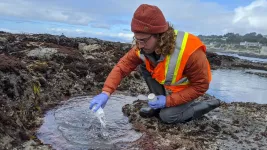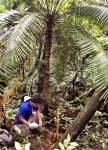(Press-News.org) TAMPA, Fla. (January 22, 2021)- The pressing concern posed by rising sea levels has created a critical need for scientists to precisely predict how quickly the oceans will rise in coming centuries. To gain insight into future ice sheet stability and sea-level rise, new research from an international team led by University of South Florida geoscientists is drawing on evidence from past interglacial periods when Earth's climate was warmer than today.
Using deposits in the caves of the Mediterranean island of Mallorca, known as phreatic overgrowths on speleothems, to reconstruct past sea level stands, the team was able to determine that the vertical extent of these unique deposits corresponds with the amplitude of the fluctuating water table, said author USF geosciences Professor Bogdan Onac. That determination now is providing scientists with a way to precisely measure past sea levels.
Working with colleagues at the University of New Mexico, University of Balearic Islands and Columbia University, the researchers' findings were published in Scientific Reports. In their project, the geosciences team documented the position and timing of sea level during key time intervals over the past 6.5 million years for which global mean sea-level estimates have been highly uncertain.
Their results contribute to the understanding of past warm periods to gain insight into the magnitude and frequency of sea level rise, which is critical for scientists' ability to forecast and make recommendations on adapting to future global warming.
The team expanded upon their research previously published in Nature, by investigating samples between 800,000 and 6.5 million years old. Using deposits from several of the Mallorcan caves and applying numerical and statistical models to estimate the corrections for glacial isostatic adjustment and long?term uplift, they translated the local sea level estimates into global mean sea level (GMSL).
Their results show that during key time events, such as Pliocene-Pleistocene Transition, when the Earth underwent a major transition from the warm climates of the Pliocene to the Pleistocene ice ages, the GMSL stood at 6.4 meters. During the beginning and the end of the Mid?Pleistocene Transition the sea level was at ?1.1 meter and 5 meters respectively.
"Overall, our results support that sea level dropped significantly after the Pliocene," said USF doctoral alum Oana Dumitru, the study's lead author who is now a postdoc at Columbia University's Lamont-Doherty Earth Observatory.
The authors also show that local sea level before and at the onset of the Messinian Salinity Crisis, a major geological event during which the Mediterranean Sea became partly to nearly dry of water, was at approximately 33 meters above present level. These estimates may offer starting points for assessing whether sea-level drawdown in the Western Mediterranean happened gradually or rapidly, the researchers said.
"Our estimates are important snapshots of sea level still stands, but additional sea level index points will be useful to yield more context for our results," the team wrote in their journal article. "By providing direct estimates of sea level using POS as robust proxies, this work advances our understanding of sea level position during several past warm periods. These results therefore contribute to efforts of studying past warm periods to gain insight into the magnitude and frequency of sea level rise."
INFORMATION:
Dumitru was joined in the research by Columbia University colleague Jacqueline Austermann; Victor J. Polyak and Yemane Asmerom of the University of New Mexico; Joan J. Fornós, Joaquin Ginés and Angel Ginés of Universitat de les Illes Balears in Mallorca, Spain.
This research is the result of a collaborative National Science Foundation (NSF) project between the University of South Florida and the University of New Mexico and part of the bilateral agreement between USF and Universitat de les Illes Balears and has been funded by NSF and the Spanish State Research Agency.
Less than two days of water quality sampling at local beaches may be all that's needed to reduce illnesses among millions of beachgoers every year due to contaminated water, according to new Stanford research. The study, published in Environmental Science & Technology, presents a modeling framework that dependably predicts water quality at beaches after only a day or two of frequent water sampling. The approach, tested in California, could be used to keep tabs on otherwise unmonitored coastal areas, which is key to protecting the well-being of beachgoers and thriving ocean economies ...
Collective research to date regarding nutrients found in the leaves of contemporary cycad species has been inconsistent as far as data collection and narrow in scope, according to a University of Guam-led literature review published on Nov. 19 in Horticulturae journal.
Understanding nutrient accumulation within cycads is essential to effective horticultural management, and more importantly, conservation of this plant group, which is highly prized within the horticulture trade and also threatened worldwide.
"Cycads comprise the most threatened group of plants worldwide, ...
Even at the start of the COVID-19 pandemic last year, people around the world became more fearful of what could happen to them or their family.
A new Flinders University study of 1040 online participants from five western countries published in PLOS ONE explores people's response to the stresses of the escalating pandemic, finding more than 13% of the sample had post-traumatic stress disorder (PTSD) related symptoms consistent with levels necessary to qualify for a clinical diagnosis.
With ongoing economic and social fallout, and death toll of more than 2 million, the team of psychology researchers warn more needs to be done to cope with ...
AURORA, Colo. (Jan. 22, 2021) - Researchers at the University of Colorado Anschutz Medical Campus have discovered a direct association between placental function in pregnant women and future metabolic disorders in children and adults, a finding that could lead to earlier intervention and diagnosis of disease.
"We've known for some time that many major diseases in adults like diabetes and cardiovascular disease are at least partly caused by problems during fetal life," said the study's senior author Thomas Jansson, MD, PhD, professor of Obstetrics & Gynecology ...
Our state of consciousness changes significantly during stages of deep sleep, just as it does in a coma or under general anesthesia. Scientists have long believed - but couldn't be certain - that brain activity declines when we sleep. Most research on sleep is conducted using electroencephalography (EEG), a method that entails measuring brain activity through electrodes placed along a patient's scalp. However, Anjali Tarun, a doctoral assistant at EPFL's Medical Image Processing Laboratory within the School of Engineering, decided to investigate brain activity during sleep using magnetic resonance ...
In a promising result for the success of vaccines against COVID-19, rhesus macaque monkeys infected with the human coronavirus SARS-CoV-2 developed protective immune responses that might be reproduced with a vaccine. The work was carried out at the California National Primate Research Center at the University of California, Davis and is published Jan. 22 in the journal Nature Communications.
"These results suggest that vaccines inducing durable protective immunity against SARS-CoV-2 do so by stimulating robust germinal center responses - a question that can be effectively answered ...
Scientists from the International Centre for Radio Astronomy Research (ICRAR) and The University of Western Australia (UWA) have set a world record for the most stable transmission of a laser signal through the atmosphere.
In a study published today in the journal Nature Communications, Australian researchers teamed up with researchers from the French National Centre for Space Studies (CNES) and the French metrology lab Systèmes de Référence Temps-Espace (SYRTE) at Paris Observatory.
The team set the world record for the most stable laser transmission by combining the Aussies' 'phase stabilisation' technology with advanced self-guiding optical ...
New research has found that growing up in a bilingual home can provide unexpected cognitive benefits later in life.
The study, published in the journal Scientific Reports, demonstrates for the first time that adults who acquired their second language as a young child (early bilinguals) are quicker at shifting attention and quicker at detecting visual changes compared to adults who learnt their second language later in life (late bilinguals).
Led by Dr Dean D'Souza of Anglia Ruskin University (ARU), the research saw 127 adults take part in two separate ...
There is a saying that you can't teach old dogs new tricks. When it comes to canine behavioral problems, age is only one factor that can predict how well a pet may respond to clinical intervention. In a paper published in Frontiers in Veterinary Science, researchers provide the first evidence on the importance of not just a dog's age, sex and size on treatment success, but the owner's personality and the kind of bond that human and animal share.
The study analyzed the physiological and psychological characteristics of 131 dog-owner pairs who attended a veterinary behavioral service over a six-month period. The statistical results were based on a behavioral assessment questionnaire that was given at the beginning, middle and end of the ...
A new collaborative study led by researchers at the National Institute for Environmental Studies, the University of Tokyo, and Michigan State University exposes the role of dams for mitigating flood risk under climate change.
Flood is amongst the costliest natural disasters. Globally, flood risk is projected to increase in the future, driven by climate change and population growth. The role of dams in flood mitigation, previously unaccounted for, was found to decrease by approximately 15% the number of people globally exposed to historical once-in-100-year ...




